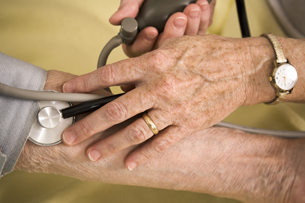Module 2
1. Module 2
1.4. Page 2
Module 2—The Endocrine System
 Explore
Explore
 Lab—Student Stress
Lab—Student Stress

© absolut/StockXpert
Think about how you feel when you are worried about exams, deadlines, sick friends, or a relationship. Your body responds with a racing heart beat, sweaty hands, fast breathing, and, maybe, sleeplessness.
In this activity you will measure one or, if possible, both of the following physiological changes:
- pulse, which is an indirect measure of heart rate
- blood pressure, which is the pressure exerted against blood vessel walls as circulating blood passes through the vessels
Note that measuring blood pressure will be dependent on the availability of a blood pressure monitor. You will complete the lab questions in the Lesson 1 Assignment. You will submit the data table, your responses to the four “Analysis” questions, and the conclusion to your teacher for assessment.
Problem (Purpose)
How does a stressful situation affect pulse and blood pressure?
Materials
- printed test questions provided by your teacher
- a stopwatch or a watch or clock with a second hand
- a blood pressure monitor: If you do not have a blood pressure monitor at home, contact your teacher to discuss your options. Many drugstores and pharmacies have blood pressure machines onsite. As well, the local health unit or a medical clinic may allow you to borrow a blood pressure monitor to complete this lab.
Procedure
Work with a partner.
Step 1: Using a watch with a second hand or a stopwatch, time your partner for 2 min as he or she sits in a comfortable chair with eyes closed and takes deep, relaxing breaths.
Step 2: When the 2-min “relaxation period” is up, take your partner’s pulse and measure his or her blood pressure. Look at the picture below for the correct placement of the fingers in order to feel the strongest pulse. If you are measuring the pulse manually, count the number of pulses in 15 s and then multiply by 4 to get the heart rate per minute. If you are using a digital blood pressure monitor, it may measure the pulse for you.
If you are using a digital blood pressure monitor, be sure to follow the instructions provided with the machine. If you are using a manual blood pressure cuff or a digital monitor, you can leave the deflated cuff on your partner’s arm for the next step.
Record the pulse and blood pressure in the data table in the Lesson 1 Assignment. These values will provide baseline data for your partner in a relaxed state.

© 2008 David Sucsy/istockphoto

© Franz Pfluegl 2006 - Fotostudio Pfluegl/istockphoto
Step 3: Note the time and administer the test to your partner. Your partner will have 2 min to complete the test questions provided by your teacher. Try to bother your partner by telling him or her to hurry up and that time is running out. This is your chance to stress out your partner!
Step 4: At the end of the 2 min shout, “Time is up!” Immediately take and record your partner’s pulse and blood pressure. Record the data for Reading 2 in the data table in the Lesson 1 Assignment. Check and record your partner’s pulse and blood pressure again after another 2 min (Reading 3), and then again 2 min after that (Reading 4).
Analysis
Complete the “Analysis” questions in the Lesson 1 Assignment.
Conclusion
In this lab, both the nervous and endocrine systems brought about the physiological changes that you measured. What conclusion can you make about how a stressful situation affects pulse and blood pressure? Which parts of the nervous and endocrine systems were involved? What can you conclude about the body’s ability to recover from stressful situations? How were the nervous and endocrine systems involved in this recovery? Write a response to these questions in the “Conclusion” part of the Lesson 1 Assignment.